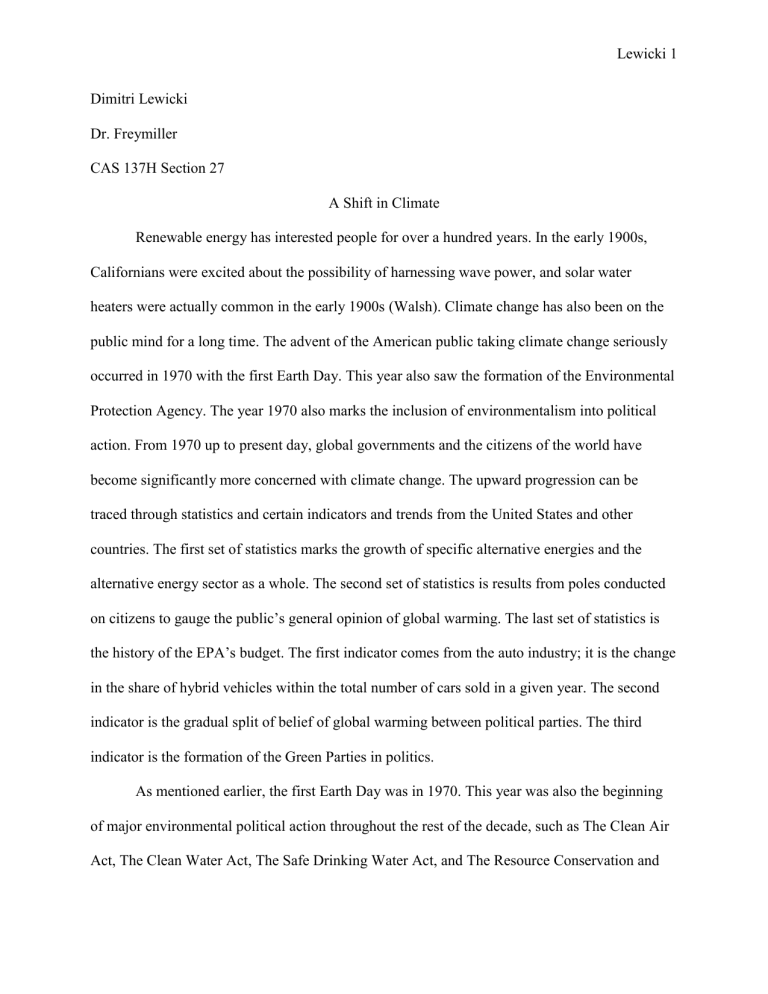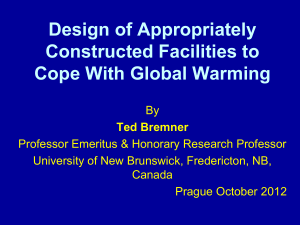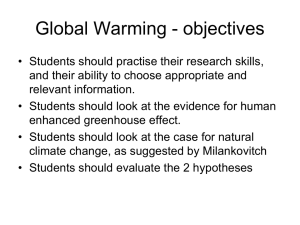CAS 137H_Paradigm Shift Essay

Lewicki 1
Dimitri Lewicki
Dr. Freymiller
CAS 137H Section 27
A Shift in Climate
Renewable energy has interested people for over a hundred years. In the early 1900s,
Californians were excited about the possibility of harnessing wave power, and solar water heaters were actually common in the early 1900s (Walsh). Climate change has also been on the public mind for a long time. The advent of the American public taking climate change seriously occurred in 1970 with the first Earth Day. This year also saw the formation of the Environmental
Protection Agency. The year 1970 also marks the inclusion of environmentalism into political action. From 1970 up to present day, global governments and the citizens of the world have become significantly more concerned with climate change. The upward progression can be traced through statistics and certain indicators and trends from the United States and other countries. The first set of statistics marks the growth of specific alternative energies and the alternative energy sector as a whole. The second set of statistics is results from poles conducted on citizens to gauge the public’s general opinion of global warming. The last set of statistics is the history of the EPA’s budget. The first indicator comes from the auto industry; it is the change in the share of hybrid vehicles within the total number of cars sold in a given year. The second indicator is the gradual split of belief of global warming between political parties. The third indicator is the formation of the Green Parties in politics.
As mentioned earlier, the first Earth Day was in 1970. This year was also the beginning of major environmental political action throughout the rest of the decade, such as The Clean Air
Act, The Clean Water Act, The Safe Drinking Water Act, and The Resource Conservation and
Lewicki 2
Recovery Act. These acts of legislation were a strong start to reforming our country’s impact on the environment and keeping its citizens safe, however, the number of major acts drastically declined following the 1970s. There was one major act in 1980, The Comprehensive
Environmental Response, Compensation and Liability Act. There was another major piece of legislation in 1990, The Pollution Prevention Act (Department of Health and Environmental
Control). It makes sense that legislative action slowed down, though, because it started out so strong and thus exhausted the need for new laws. And despite this decline, there is much proof to follow that clearly demonstrates the upward trend of belief in global warming from 1970 to present day.
The public’s reactions to green technology are traceable back to the 1970s through an examination of the history of the industry. The International Energy Agency provides several growth statistics for the past decade that suggest an increase in people’s concern for climate change and thus belief in global warming. For example, total global installed capacity for wind energy grew from 18 gigawatts in 2000 to 238 gigawatts in 2011. Another similar statistic displays the growth in global production of bio-fuel. In 2000, it was at sixteen billion liters, and in 2010, it was at 100 billion liters. Solar photovoltaic energy has experienced amazing growth as well: with a capacity of just 1.5 gigawatts in 2000, it grew to 65 gigawatts by the end of 2011
(International Energy Agency). Energy & Capital, a company that analyzes energy investments, sums up the growth of renewable energies since 2004. According to their statistics, global renewable energy capacity has increased by 75% since 2004 (Hodge). These increases in production of green energy alternatives show that the public around the globe during the last decade increasingly believes in global warming because they are demanding alternative energy sources.
Lewicki 3
There have been studies conducted on public opinion that suggest an increase in belief of global warming. For example, another statistic comes from a study on Americans’ belief of
Global Warming: in 2012 70% of Americans have said they believe in global warming, the highest it’s been since before the 2008 recession, when it peaked at 71% before the economy crashed. The current percentage has grown from 57% in 2010, when the recession was first-andforemost on the public mind. During the recession, people were far more concerned with the economy than with global warming. One reason for the drastic increase since 2010, study authors cite, is the influx of chaotic and out of the ordinary weather patterns. For example, this summer was the third hottest summer on our country’s records, and the entire year has the potential to be our nation’s hottest ever year. Other research from the same study found that for the first time since 2008, more than half of Americans believe Global Warming is caused mostly by human activities (Morin). Through these statistics, it is evident that the public belief of global warming in the United States has increased over recent years.
The study of the Environmental Protection Agency’s budget over the past forty years shows highs and lows in the budget, but an overall upward trend in the allocation of money to that agency. In 1970, when the Federal government formed the EPA, the budget was
$1,003,984,000. In 2012, it was $8,449,385,000. Although there has been inflation since 1970, the rate is nothing compared to the budget rate increase of more than 800%. During the years from 1974 to 1976, 1980 to 1986, and from 2011 to 2012 there were drastic declines in the budget (Environmental Protection Agency). These three periods have all been during times of economic troubles, when the American public put the economy above the environment in terms of the most urgent concern. Despite lows, allocation of money to the EPA has clearly grown
Lewicki 4 since 1970, deomonstrating an increased priority on environmental protection in the United
States.
The first indicator representing that overall concern for global warming has gone up over the last decade is the sale of hybrid vehicles. The percent share of hybrid cars in the car industry can in part represent the trend of the green technology and alternative energy sectors. In 2002, hybrid cars made up roughly 0.25% of total cars sold that year. In 2011, they made up roughly
2.1% of total cars sold that year (Valdes-Dapena). This large growth gives insight into how miles-per-gallon and emissions have become more important to consumers when choosing a new car, thus showing an upward shift in the public’s concern over global warming over the last decade.
One way of looking at global warming and its standing in politics provides a second indicator demonstrating the growth of the importance of global warming to the government and public. In the 1970s, global warming came on to the political stage and gained enough support to pass several major pieces of legislation that protected the environment and people from pollution. At the time, environmentalism was not particularly more popular amongst either major political party in the United States. As the years went by, opinions of global warming became increasingly split across party lines. For example, President Nixon formed the Environmental
Protection Agency in 1970 (Connecticut). Whereas today, there are far more Republicans who deny global warming than Democrats who deny it. In 2010 there was a 41% gap between the percent of Democrats who believe the effects of global warming have already begun and the percent of Republicans who do (“Phys.org”). The EPA is also one of the agencies that fiscal conservatives, such as Republicans and Libertarians, want to drastically cut funding to. If the same party that created the EPA thirty to forty years earlier now wants it to whither away, there
Lewicki 5 has clearly been a major transition for the party around global warming and environmental issues. Al Gore’s movie, “An Inconvenient Truth,” accelerated the split between liberals and conservatives over global warming in 2006 and changed the course of global warming in politics forever (Brooks). U.S. politics are well known for sharp disagreements and distinctions between the Democrats and Republicans over the more important topics and issues. Therefore, the split between the Democrats and Republicans over global warming certifies that the topic has become far more political than it was in the 1970s and has become a major topic of discussion and concern within government and among the people.
The politicization of global warming is evident through the history of the splitting of opinions across party lines, but it is also apparent from the addition of the Green Parties in politics. The Green Parties, political parties whose priorities are focused on environmentalism, started at the state level in the early 1980s and later came together to form various united Green
Parties, such as the Greens/Green Party USA (1991-present) and the Green Party of the USA
(2001-present), which are the two major Green Parties involved in US politics today (“How Stuff
Works”). For multiple political parties to be formed around environmentalism, it must mean that global warming is really important to the public, and certainly more important than before the parties existed, such as the 1970s.
Global warming and climate change are topics that concern the majority of Americans and many people around the world. As a result, they concern many governments as well, through pressure delivered by constituents and citizenry. At one point, though, it was not like that. It has been forty-two years since the first Earth Day and the formation of the EPA, and over that time, the topic of global warming has been gaining a foothold in the world’s concerns, climbing up the ladder of governments’ priorities. It now toes the line with other topics in politics such as
Lewicki 6 economics and national defense. In the future, people will look back on this time as a transition period, when the shift from the denial of environmental problems turned into debate and a split of public opinion, and then finally moved into acceptance of responsibility. Having for the most part accepted climate change as a fact, the world needs to start making more significant sacrifices and enact solutions to the problems we created.
Lewicki 7
Works Cited
Brooks, David. “The New York Times.” New York Times. (2012): n. page. Web. 25 Oct. 2012.
<http://www.nytimes.com/2012/10/19/opinion/brooks-a-sad-green-story.html?_r=0>.
Connecticut. Department of Energy & Environmental Protection. 2012. Print.
<http://www.ct.gov/dep/cwp/view.asp?a=2688&q=456018&depNav_GID=1511>.
Hodge, Nick. "Energy & Capital." Energy & Capital. (2009): n. page. Web. 5 Nov. 2012.
<http://www.energyandcapital.com/articles/renewable-energy-statistics/900>.
"How the Green Party Works." How Stuff Works. n.d. n. page. Print.
<http://people.howstuffworks.com/green-party2.htm>.
Morin, Monte. “LA Times.” LA Times. (2012): Oct. Web. 25 Oct. 2012.
<http://www.latimes.com/news/science/sciencenow/la-sci-sn-climate-change-poll-
20121018,0,5956821.story>.
"Phys.org." Phys.org. (2011): n. page. Print. <http://phys.org/news/2011-04-democratsrepublicans-increasingly-global.html>.
South Carolina. Department of Health and Environmental Control. Brief History of
Environmental Law. Print.
<http://www.scdhec.gov/environment/lwm/recycle/pubs/environmental_law.pdf>.
“Topics." International Energy Agency. N.p., n.d. Web. 3 Nov 2012.
<http://www.iea.org/topics/>.
United States. Environmental Protection Agency. EPA's Budget and Spending. 2012. Web.
<http://www.epa.gov/planandbudget/budget.html>.
Valdes-Dapena, Peter. "Hybrid Car Sales: Lots of options, few takers." CNNMoney. 30 2011: n. page. Print. <http://money.cnn.com/2011/09/30/autos/hybrid_car_sales/index.htm>.
Lewicki 8
Walsh, Bryan. “The Surprisingly Long History of Green Energy.” Time Magazine. 06 2011: n. page. Web. 25 Oct. 2012.
<http://www.time.com/time/health/article/0,8599,2063521,00.html>.







